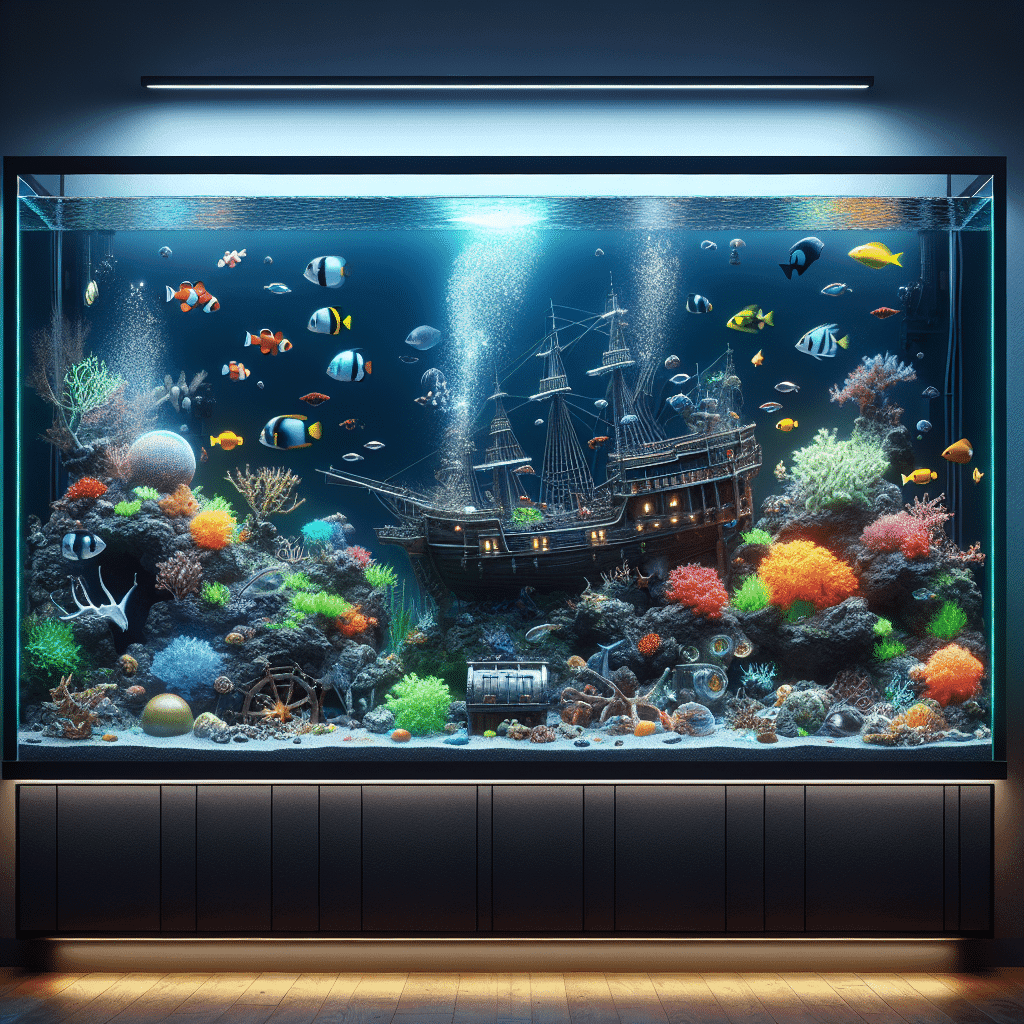Understanding Alkalinity
Definition and Measurement
Alkalinity is a measure of water’s ability to resist changes in pH, ensuring a stable environment for aquatic life. It indicates the capacity of water to neutralize acids, which is crucial for maintaining a balanced ecosystem in my saltwater aquarium. Alkalinity is typically measured in milligrams per liter (mg/L) of calcium carbonate (CaCO3) using a process called titration. In this process, I add an acid of known strength to the water to determine how much is needed to reach a specific pH level.
| Alkalinity Level (mg/L CaCO3) | pH Range |
|---|---|
| Low (0 – 50) | Acidic (pH < 7) |
| Moderate (50 – 150) | Neutral (pH 7 – 8) |
| High (150+) | Alkaline (pH > 8) |
Importance of Alkalinity
The importance of alkalinity in an aquarium can’t be overstated! It plays a vital role in the health of ecosystems, marine life, and even humans. Aquatic organisms thrive in a pH range of 6.0 to 9.0, and sudden changes in water pH can stress or harm these organisms. Maintaining proper alkalinity levels ensures that my fish and corals have a stable environment. Additionally, alkalinity is essential for wastewater and drinking water treatment since it helps maintain optimal pH levels during treatment processes.
In summary, effective alkalinity management is key to a thriving reef tank. Monitoring and adjusting alkalinity can lead to a healthier aquatic environment, benefiting both the marine life I care for and the overall success of my aquarium setup. For more information on setting up my saltwater aquarium, I can check out our guide on saltwater aquarium setup.
Factors Influencing Alkalinity
Understanding what influences alkalinity is crucial for anyone managing a saltwater aquarium. I find it fascinating how various factors, from geology to wastewater treatment, play a role in the alkalinity levels in our marine tanks. Here’s a closer look at two significant influences: geology and soil acidity, and effluent from wastewater treatment.
Geology and Soil Acidity
Local geology has a major impact on the alkalinity of water. When water flows through soils and rocks, it picks up minerals along the way. In areas where there are high concentrations of carbonate minerals, the water becomes more alkaline. Conversely, regions with low-alkalinity soils and rocks, such as those with igneous rocks like granite, usually lead to lower alkalinity levels in water. This is essential to remember when setting up a saltwater aquarium, as the source water can greatly influence your tank’s stability.
| Soil Type | Alkalinity Influence |
|---|---|
| High Carbonate Concentration | Increases alkalinity |
| Igneous Rocks (e.g., granite) | Decreases alkalinity |
Effluent from Wastewater Treatment
Another critical factor affecting alkalinity is the effluent from wastewater treatment plants. The characteristics of this effluent can significantly influence the alkalinity of nearby natural water bodies, including streams and lakes. Cleaning agents and food residues often contain bicarbonates and carbonates, which are washed into surface waters from drains. This can lead to increased alkalinity in the receiving waters, affecting the overall health of the aquatic ecosystem.
Managing alkalinity levels is vital for the health of marine life, as it helps maintain a stable pH environment, which is necessary for fish and other organisms to thrive (WWDMag). When I think about aquarium maintenance, ensuring that I monitor these factors is essential to create a thriving habitat for my marine species.
Understanding these influences helps me make informed decisions about my aquarium’s water chemistry. By keeping an eye on the geology of my water source and the impact of local wastewater, I can ensure that my tank remains healthy and stable.
Alkalinity in Water Systems
Understanding the significance of alkalinity in water systems is essential for anyone interested in maintaining a healthy aquarium. It plays a crucial role in the health of ecosystems, aquatic life, and even human health.
Ecosystem Health
Alkalinity acts as a buffer in water systems, helping to resist changes in pH levels. This buffering capacity is vital for the stability of aquatic ecosystems. Most aquatic organisms thrive in a pH range of 6.0 to 9.0. Sudden pH changes can stress or harm these organisms, making it essential to manage alkalinity effectively. Maintaining proper alkalinity levels ensures that the ecosystem remains balanced and healthy.
| pH Level | Condition |
|---|---|
| 6.0 – 9.0 | Optimal range for aquatic life |
| Below 6.0 | Acidic conditions, harmful to ecosystems |
| Above 9.0 | Alkaline conditions, can stress organisms |
Impact on Aquatic Life
Alkalinity is particularly important for fish and other aquatic organisms. It protects them from rapid pH changes, which can be detrimental to their health. Higher alkalinity levels in surface waters help buffer against acid rain and other acidic wastes, preventing harmful fluctuations in pH (KnowYourH2O). In my experience, maintaining stable alkalinity levels has led to happier and healthier fish in my aquarium.
Role in Human Health
Alkalinity also has implications beyond aquatic life; it is vital for human health as well. It helps maintain pH levels in drinking water, acting as a protector for both health and piping systems. Proper alkalinity ensures that drinking water remains safe and free from harmful acidity (ChemREADY). When managing my aquarium, I always consider how alkalinity affects not just the fish, but the broader water system as well.
By understanding the roles of alkalinity in water systems, I can make informed decisions for my aquarium that benefit both the aquatic life within it and the overall ecosystem. For more information on how to manage your aquarium effectively, check out our guide on saltwater aquarium setup and aquarium maintenance.
Managing Alkalinity Levels
As a reef tank enthusiast, understanding how to manage alkalinity levels is key to creating a thriving aquatic environment. Two critical aspects of alkalinity management are pH regulation and buffering capacity. Let’s dive into each of these components and discover why they matter so much for our underwater friends.
pH Regulation
Alkalinity plays a pivotal role in regulating pH levels within your aquarium. Aquatic organisms thrive in a pH range of 6.0 to 9.0, and maintaining this balance is essential for their health and wellbeing. Sudden changes in pH can stress or even harm these delicate creatures.
To ensure stable pH levels, it’s important to regularly test the water and adjust alkalinity as needed. High alkalinity helps buffer against acid inputs from sources like acid rain or waste, protecting your tank from harmful fluctuations. For tips on managing pH levels effectively, check out our guide on pH management.
| Alkalinity Level | pH Stability Range |
|---|---|
| Low (0-80 mg/L) | 6.0 – 6.5 |
| Moderate (80-120 mg/L) | 6.5 – 8.0 |
| High (120+ mg/L) | 8.0 – 9.0 |
Buffering Capacity
Buffering capacity refers to water’s ability to resist pH changes when acids are introduced. This is where alkalinity truly shines. Alkalinity is a measure of the water’s ability to neutralize acids, thanks to compounds like bicarbonates, carbonates, and hydroxides (UMass Amherst).
In my experience, maintaining high alkalinity helps protect against rapid pH changes, which is especially important in a reef tank. For example, water with higher alkalinity can buffer acid rain or other acid wastes, preventing harmful pH changes that could stress fish and corals.
To maintain optimal buffering capacity, regular testing is essential. If you notice alkalinity levels dropping, consider adding alkalinity-boosting products, or performing water changes to restore balance. For more details on maintaining water quality, explore our article on aquarium maintenance.
| Buffering Capacity | Effect on pH |
|---|---|
| Low | Prone to rapid pH drops |
| Moderate | Stable pH but can fluctuate |
| High | Resistant to pH changes |
By understanding pH regulation and buffering capacity, I can confidently manage alkalinity levels in my reef tank, ensuring a healthy and vibrant ecosystem for my aquatic companions. Remember, consistent monitoring and adjustments are key to alkalinity management success! For more tips on maintaining your reef tank, check out our guide on saltwater aquarium setup.
Alkalinity in Industrial Applications
Understanding alkalinity management is not only crucial for marine aquariums but also plays a significant role in various industrial applications, particularly in wastewater treatment and sustainable management practices. I find it fascinating how the same principles apply across different environments.
Wastewater Treatment
In industrial settings, managing alkalinity in wastewater is essential for maintaining environmental safety and compliance. The traditional approach to neutralizing alkaline wastewater involved using mineral acids, such as hydrochloric acid (HCl) and sulfuric acid (H2SO4). However, this method poses challenges related to pricing, storage, safety, and handling of these highly corrosive substances (Water Technology Online).
An innovative solution has emerged with the SOLVOCARB® process from Linde North America, which utilizes carbon dioxide (CO2) for neutralization. This method provides a fast and economical way to lower pH levels in wastewater while ensuring a high degree of control. Using CO2 allows for dynamic regulation of the neutralization process without the negative effects associated with mineral acids.
| Method | Advantages | Disadvantages |
|---|---|---|
| Mineral Acids | Effective pH reduction | Corrosive, safety concerns, high handling costs |
| CO2 Neutralization | Safe, efficient, sustainable | Requires appropriate infrastructure |
Sustainable Management Practices
Sustainable practices in alkalinity management are becoming increasingly vital in the industry. The innovative use of captured CO2 from smokestacks to create carbonic acid exemplifies this approach. This not only aids in pH neutralization but also reduces reliance on hazardous chemical neutralizers, enhancing both efficiency and sustainability in treatment plants.
Using CO2 to treat wastewater involves dissolving it in alkaline water, where it reacts to form carbonic acid, effectively lowering the pH. This method can be integrated into existing infrastructures with minimal adaptations, making it a practical solution for industries like textiles.
Sustainable alkalinity management is crucial for protecting aquatic ecosystems while ensuring compliance with environmental regulations. By adopting these innovative practices, industries can significantly improve their impact on the environment while maintaining operational efficiency. For those interested in maintaining healthy ecosystems in their aquariums, understanding these industrial practices can enhance our approach to aquarium maintenance and water changes in our marine environments.
Alkalinity Testing and Measurement
Understanding how to test and measure alkalinity is essential for maintaining a thriving saltwater aquarium. I get excited about the process because it empowers me to ensure my marine life thrives! In this section, I’ll cover the titration process and the importance of electrode care for accuracy.
Titration Process
Alkalinity is measured using a process called titration. In this method, an acid of known strength is added to the water sample to determine how much acid is needed to reach a specific pH level. The measurement is given in milligrams per liter (mg/L) of calcium carbonate (CaCO3).
Here’s a quick overview of how the titration process works:
- Prepare the Water Sample: Collect a water sample from your aquarium.
- Add Acid: Slowly add a sulfuric acid solution to the water.
- Monitor pH Levels: Use a pH indicator to monitor the pH level. The goal is to titrate the sample to a pH of 4.5 and then to 4.2.
- Calculate Alkalinity: The difference in the amount of titrant used gives the alkalinity measurement in mg/L of calcium carbonate. This method ensures accurate measurement using a double end-point alkalinity formula (UMass Amherst).
| Step | Action | Measurement |
|---|---|---|
| 1 | Prepare water sample | – |
| 2 | Add acid (sulfuric) | – |
| 3 | Titrate to pH 4.5 then 4.2 | – |
| 4 | Calculate alkalinity | mg/L CaCO3 |
Electrode Care for Accuracy
Taking care of the pH electrodes is crucial for obtaining accurate readings. The accuracy of my measurements directly depends on the condition of these electrodes. Here are some key points to consider for proper electrode care:
- Storage: Always store electrodes in a suitable solution to keep them hydrated.
- Response Testing: Regularly test the response of electrodes to ensure they are functioning properly.
- Rejuvenation: Follow rejuvenation procedures if the electrodes seem sluggish or unresponsive.
- Calibration: Perform calibration regularly to maintain measurement accuracy in water samples (UMass Amherst).
By following these tips, I can ensure that my alkalinity management is on point, leading to a healthy and vibrant saltwater aquarium. For more information on maintaining my aquarium, I can explore topics like aquarium maintenance and water changes.
Alkalinity and Environmental Impact
Understanding how alkalinity affects the environment is essential for anyone involved in aquarium management. I find it fascinating how alkalinity plays a role in both acid neutralization and resource recovery opportunities.
Acid Neutralization
Alkalinity is a measure of a water body’s ability to neutralize acids, a crucial factor for maintaining a stable ecosystem. It involves alkaline compounds like bicarbonates, carbonates, and hydroxides that work to remove hydrogen ions (H+) from the water, thereby lowering its acidity. This buffering capacity is vital for the health of marine life, as aquatic organisms thrive within a pH range of 6.0 to 9.0. Sudden changes in pH can stress fish and other aquatic organisms, making alkalinity management essential (WWDMag).
In my own experience, maintaining optimal alkalinity levels not only protects aquatic life but also plays a significant role in wastewater treatment. It helps to stabilize pH levels, ensuring that harmful pollutants like acid rain have a reduced impact on the ecosystem. Here’s a quick overview of how alkalinity contributes to acid neutralization:
| Buffering Capacity | Effect on pH Levels | Impact on Aquatic Life |
|---|---|---|
| High Alkalinity | Stabilizes pH, reducing fluctuations | Promotes healthy ecosystems |
| Low Alkalinity | Increased vulnerability to acid inputs | Stress and harm to aquatic organisms |
Resource Recovery Opportunities
Alkalinity management also opens up exciting opportunities for resource recovery. In industrial applications, alkaline wastewater can produce leachates enriched with trace metals. While these metals can be harmful, they also present a chance for recovery and reuse. Effective management practices can prevent environmental contamination and allow us to reclaim valuable resources (Journal of Cleaner Production).
Traditional methods for neutralizing alkaline wastewater often involve using strong mineral acids, which can be costly and may have negative environmental impacts. By exploring alternative approaches, we can effectively neutralize alkaline wastewater while minimizing harmful effects (Water Treatment Magazine).
In summary, understanding the relationship between alkalinity and environmental impact is vital for anyone involved in aquarium care. It not only helps protect aquatic life but also offers innovative ways to manage resources sustainably. For more information on maintaining a thriving aquarium, check out our articles on saltwater aquarium setup and aquarium maintenance.
Alkalinity and Water Infrastructure
Effects of High Alkalinity
As a fish tank and reef tank hobbyist, understanding the effects of high alkalinity in my aquarium is essential. High alkalinity can result in calcium carbonate buildup, leading to scale formation. This scale can clog pipes and hinder water flow, which is a serious issue for maintaining a healthy aquatic environment. In extreme cases, this buildup can even cause pipe bursts and weaken the overall infrastructure of the aquarium system (ChemREADY).
Here’s a quick overview of the potential issues caused by high alkalinity:
| Effect | Description |
|---|---|
| Calcium Carbonate Buildup | Accumulation of scale in pipes |
| Clogged Pipes | Reduced water flow and efficiency |
| Pipe Bursts | Potential leaks and structural damage |
| Weakened Infrastructure | Overall integrity of the system compromised |
Maintaining Balance in Water Systems
To avoid the negative consequences of high alkalinity, I find that maintaining a proper balance is crucial. This balance helps prevent pipe clogging and ensures optimal water flow throughout my aquarium. Regular monitoring of alkalinity levels is important to ensure they remain within a healthy range.
Implementing regular water changes can help manage alkalinity levels effectively. Additionally, using a quality saltwater aquarium setup can assist in maintaining the right balance. I also pay close attention to equipment placement and light management to optimize conditions within my tank.
By understanding the interplay between alkalinity and water infrastructure, I can better protect my aquarium, ensuring it remains a thriving environment for my aquatic life. For those interested in learning more about maintaining water quality, checking out my articles on water safety and aquarium maintenance can be helpful.



